Have you ever found yourself in a sticky situation, literally, with wood stain smeared all over your skin? Trust me, I’ve been there too. After accidentally staining my hands during a DIY project and struggling to wash it off, I dove into research mode.
In this blog post, I’ll share ten simple but effective methods for removing wood stains from skin – solutions gleaned from professional painters to chemistry experts! Ready for the secret spill? Let’s dive in!
Key Takeaways
- Wearing protective gloves, and old clothes, and keeping a wet rag handy can prevent wood stains from getting on your skin while working.
- Soap and water, natural oils like vegetable oil or coconut oil, baking soda paste, white vinegar, and lemon juice are effective methods for removing wood stains from the skin.
- Rubbing alcohol is a powerful solvent that can be used to remove stubborn wood stain stains from the skin.
- Always take precautions when using any method or solution to remove wood stains from your skin and seek medical advice if necessary.
How to Prevent Wood Stain from Getting on Your Skin
Wear protective gloves
Slipping on a pair of protective gloves is my first line of defense when preventing wood stain from making contact with my skin. These gloves act as a reliable barrier between the harsh chemicals in the stain and your sensitive skin.
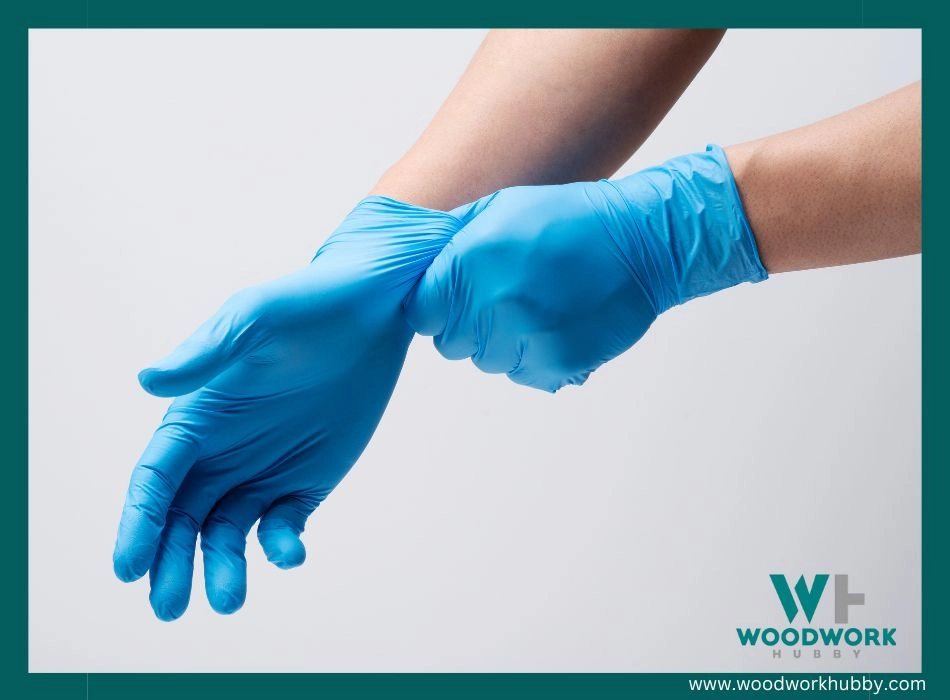
In fact, it’s just like having an extra layer of invincible skin! It’s especially crucial to wear these if you have sensitive or easily irritated skin. Plus, they make cleaning up a whole lot easier; once you’re done staining your project, all you need to do is take off the gloves – no scrubbing required!
Wear old clothes
Rolling up your sleeves and getting down to a home improvement project like staining wood can be rewarding. But, as I’ve learned over the years, it’s essential to wear old clothes.
No matter how careful you think you might be, there’s always the chance of accidental spills or stray droplets finding their way onto your attire.
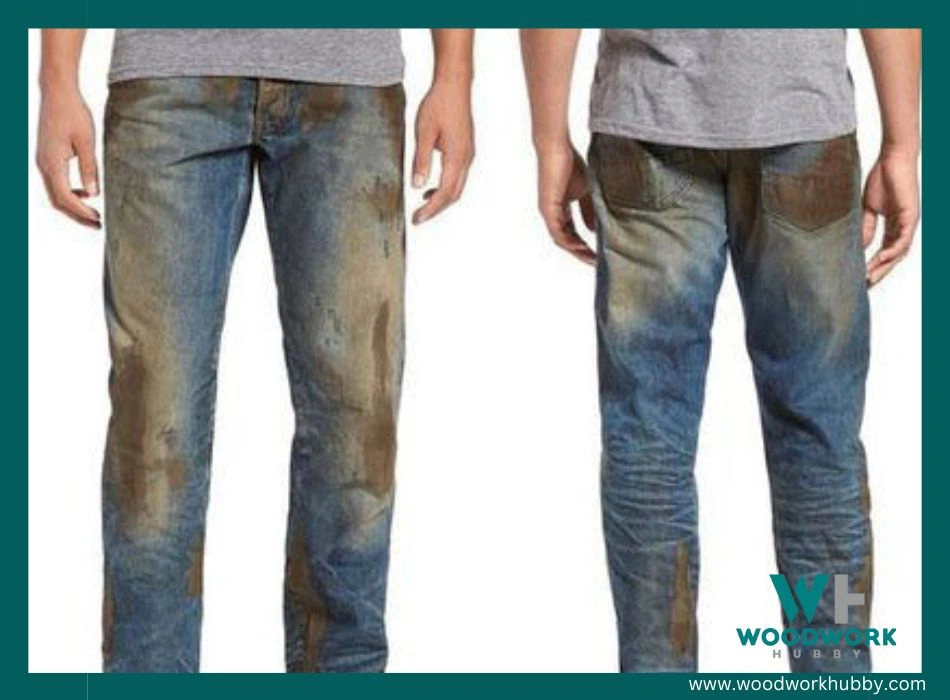
The kind of clothes becomes all the more crucial if we are going to confront wood stains since they are notoriously difficult to remove from fabric once dry. An old pair of jeans and a worn-out shirt will do just fine – these could take some stain without causing heartbreaks!
If any wood stains find their way on these garments, you won’t stress about it because these are already designated for such messy tasks.
So yes, protecting skin from wood stain begins with donning those stained overalls that eagerly wait in your wardrobe for DIY days like this one!
Keep a wet rag handy
Keeping a wet rag handy is an essential step in preventing wood stain from landing on your skin. Stain accidents can happen unexpectedly, even to the most careful DIY enthusiasts or professionals.
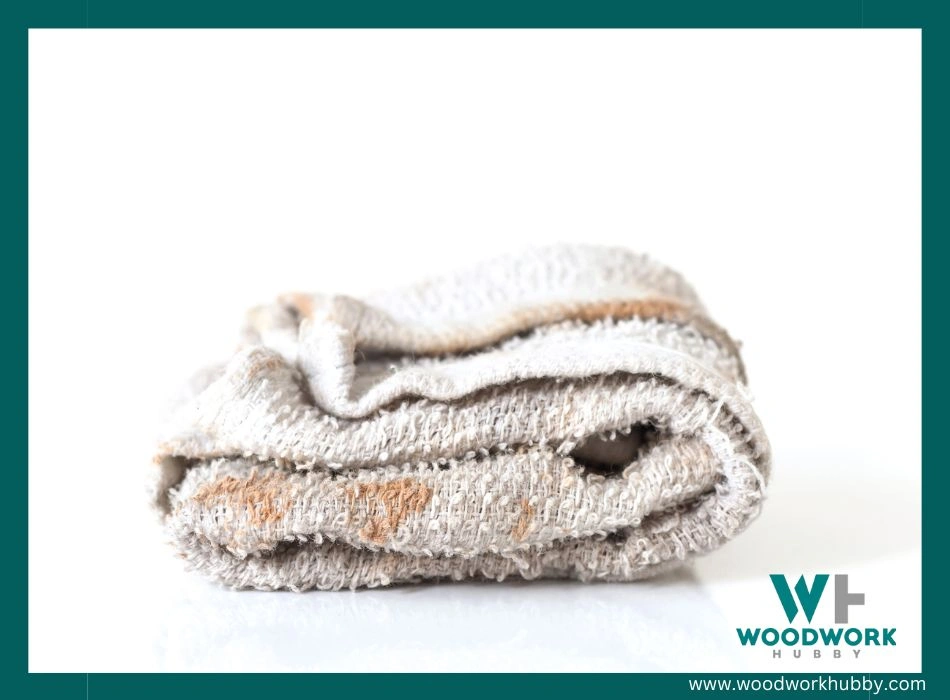
Should you find wood stain splashing onto your uncovered skin during application, you can readily wipe it off with a handy wet rag before the stain seeps into your skin and causes potential harm.
This damp cloth acts as a quick response tool that helps prevent prolonged contact of oil-based stains which are notably harder to remove than water-based ones due to their potent solvents for effective dyeing capabilities.
So remember the golden rule: ‘Keep a wet rag within arm’s reach’. It’s easy, and practical, and promotes safe stain removal methods while working with wood stains!
Use lotion
I always make sure to have lotion on hand when working with wood stain to prevent it from getting on my skin. Applying lotion before starting the staining process creates a barrier between the stain and your skin, making it easier to remove later on.
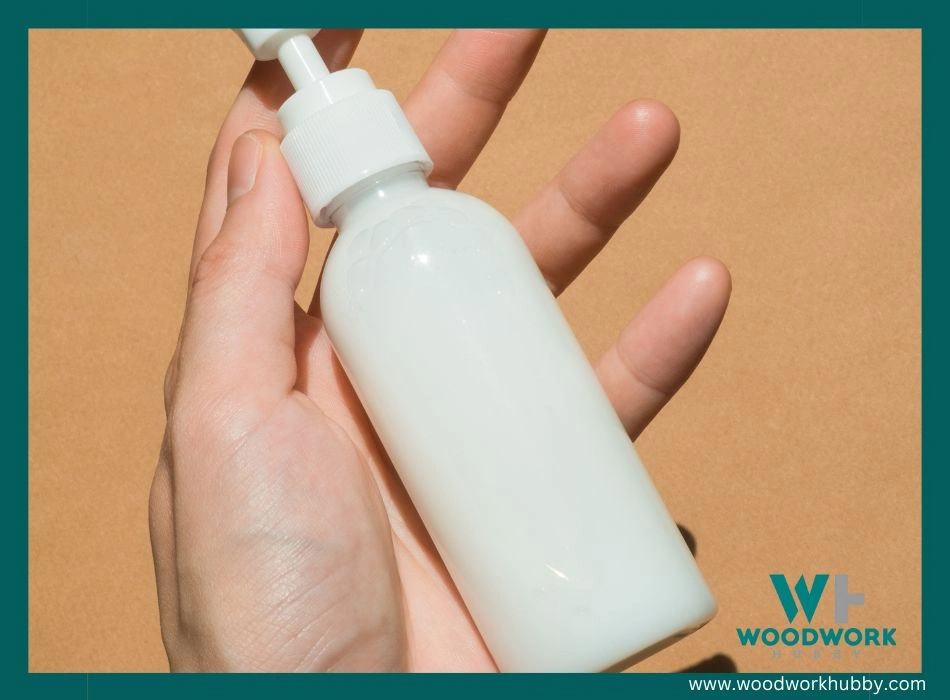
It also helps keep your hands moisturized, which can prevent dryness and irritation caused by harsh chemicals in the stain. So, don’t forget to grab some lotion before you start staining!
Methods to Remove Wood Stain from Skin
Soap and water
To remove wood stains from your skin, one simple and effective method is to use soap and water. This common household item can help break down the stain and wash it away. Here’s how you can use soap and water to remove wood stains from your skin:
- Wet your hands or the stained area with warm water.
- Apply a generous amount of mild soap or dish detergent to your hands or a washcloth.
- Gently rub the soap into the stained area, creating a lather.
- Continue scrubbing for a few minutes, focusing on the stained parts of your skin.
- Rinse your hands or the stained area thoroughly with warm water until all the soap is gone.
- Pat your skin dry with a clean towel.
Natural oils
Natural oils are a great option for removing wood stain from your skin. Here are some natural oils that can effectively remove stubborn stains:
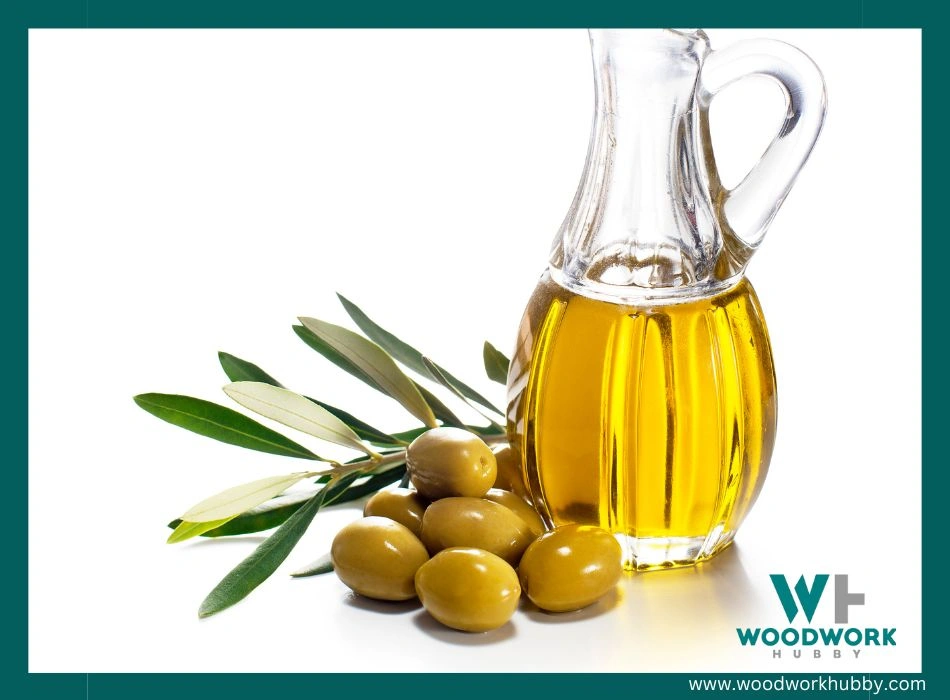
- Vegetable oil: This common cooking oil has cleansing properties that can break down the pigments in wood stains.
- Olive oil: Like vegetable oil, olive oil is an effective natural cleanser for wood stain on the skin.
- Coconut oil: Known for its moisturizing properties, coconut oil can also help remove wood stain from the skin.
- Canola oil: Another versatile cooking oil, canola oil works well in breaking down wood stain pigments.
Baking soda
Baking soda is an effective and natural remedy for removing wood stain from your skin. Here’s how you can use it:
- Create a paste: Mix equal parts of water and baking soda to create a thick paste. Make sure the mixture has a smooth consistency.
- Apply the paste: Gently apply the baking soda paste onto the stained areas of your skin. Use your fingers or a soft cloth to spread the paste evenly.
- Scrub gently: Using circular motions, gently scrub the stained areas with the baking soda paste. This will help lift off the wood stain from your skin.
- Rinse with water: After scrubbing, rinse off the baking soda paste with warm water. Ensure that all traces of the wood stain are removed.
- Repeat if necessary: If there are still some lingering stains on your skin, you can repeat the process until they are completely gone.
White vinegar
White vinegar is a highly effective method for removing wood stain from your skin. Its acidic properties help to break down the stain and lift it away. Here’s how you can use white vinegar to remove wood stain from your skin:
- Soak a cotton ball or pad in white vinegar.
- Gently rub the stained area with the vinegar – soaked cotton ball, applying light pressure.
- Continue rubbing until the stain starts to lift off of your skin.
- Rinse the area with warm water and pat dry.
Lemon juice
Lemon juice is a powerful natural remedy that can be used to remove wood stain from the skin. It contains citric acid, which acts as a potent cleanser and stain remover. Here are some methods to use lemon juice for wood stain removal:
- Squeeze fresh lemon juice onto the stained area of the skin.
- Let the lemon juice sit on the stain for a few minutes to allow it to break down the pigments.
- Gently scrub the area with a soft brush or cloth to help lift the stain.
- Rinse with warm water and pat dry.
- Mix equal parts lemon juice and baking soda to create a paste.
- Apply the paste onto the stained skin and let it sit for a few minutes.
- Gently scrub the area using circular motions.
- Rinse with warm water and pat dry.
Chemical Solutions for Wood Stain Removal
To tackle tougher wood stain stains, try using chemical solvents like rubbing alcohol, acetone, or mineral spirits. These powerful solutions can effectively remove stubborn stains from the skin.
Rubbing alcohol
Rubbing alcohol is a great chemical solution for removing wood stain from your skin. It is a solvent that can easily dissolve the stain, making it easier to remove. Here are some steps to effectively use rubbing alcohol for wood stain removal:
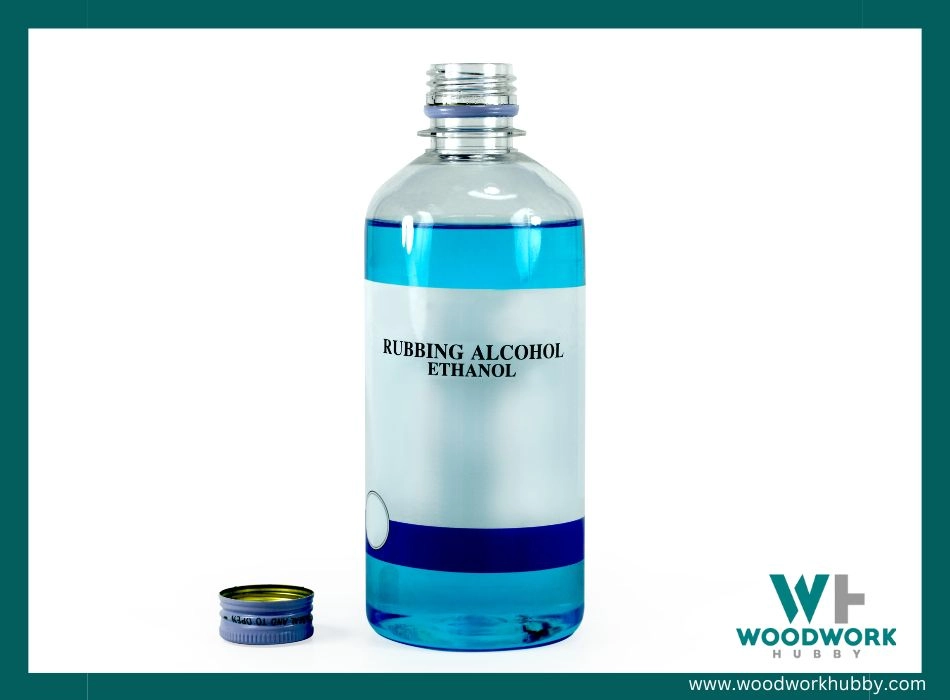
- Apply a small amount of rubbing alcohol onto a cotton ball or rag.
- Gently rub the stained area with the soaked cotton ball or rag.
- Continue to rub in circular motions until the stain starts to lift off.
- If necessary, apply more rubbing alcohol and continue to rub until all of the stain is removed.
- Once the stain is gone, rinse your skin with soap and water to remove any residue.
Acetone
Acetone is a highly effective chemical solution for removing wood stain from the skin. It is a solvent that can easily break down the stain and help lift it off the surface of the skin. Here are some key points to remember when using acetone for wood stain removal:
- Acetone is commonly found in nail polish removers and can be used as a home remedy to remove wood stain from the skin.
- To use acetone, soak a cotton ball, cotton round, or old rag in the liquid.
- Gently rub the stained area with the acetone – soaked material.
- The acetone will dissolve the wood stain and make it easier to remove.
- Be cautious not to rub too vigorously to avoid irritating or damaging your skin.
- After removing most of the stain, wash your skin with soap and water to ensure all residue is removed.
- Remember to moisturize your skin after using acetone, as it can be drying.
Mineral spirits
Mineral spirits, also known as paint thinner, are effective chemical solutions for removing wood stain from the skin. They can easily dissolve the stain and help in its removal. Here are the steps to use mineral spirits for removing wood stain:
- Apply a small amount of mineral spirits to a cotton ball or rag.
- Gently rub the stained area with the soaked cotton ball or rag.
- Continue rubbing until the wood stain starts to lift off the skin.
- If necessary, repeat the process with fresh mineral spirits until all traces of the stain are gone.
- After removing the wood stain, wash the skin thoroughly with soap and warm water to remove any residue.
Final Thoughts – Wood Stain Remover Secrets
In conclusion, removing wood stain from skin doesn’t have to be a daunting task. By following these simple tips and using the right methods, you can easily remove wood stain from your skin.
Whether it’s using natural oils or chemical solvents, there are plenty of options to choose from. Remember to always take precautions and protect your skin when working with wood stain.
With these secrets in hand, you’ll never have to worry about those stubborn stains again!
Conclusion
In conclusion, removing wood stain from your skin doesn’t have to be a daunting task. With the right methods and solutions, you can easily get rid of those stubborn stains. Whether you choose natural oils or chemical solvents, always remember to protect your skin and use caution when applying these remedies.
By following these tips, you’ll be able to keep your hands clean and stain-free while working on your next woodworking project.
FAQs
1. How do I remove wood stain from my skin?
To remove wood stain from your skin, you can start by washing the affected area with soap and warm water. If the stain persists, try using a natural oil or rubbing alcohol to gently scrub the stained area. You can also use a commercial stain remover specifically designed for removing wood stains.
2. What should I avoid when trying to remove wood stain from my skin?
When trying to remove wood stain from your skin, it is important to avoid using harsh chemicals or abrasive materials that could irritate or damage your skin. Avoid scrubbing too vigorously as this may cause further irritation.
3. Can I prevent wood stain from staining my skin in the first place?
Yes, there are several ways you can prevent wood stain from staining your skin. Wearing gloves while working with wood stains is highly recommended. You can also apply a barrier cream or lotion to create a protective layer on your skin before coming into contact with the stain.
4. What should I do if the wood stain causes an allergic reaction on my skin?
If you experience an allergic reaction to wood stain on your skin, such as redness, itching, swelling, or rash, it is important to seek medical attention immediately. An allergist or dermatologist will be able to provide appropriate treatment based on your specific situation and symptoms.




